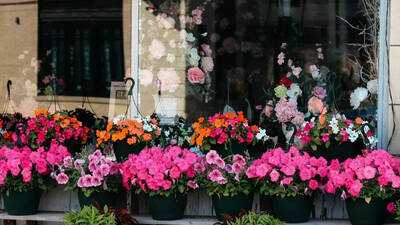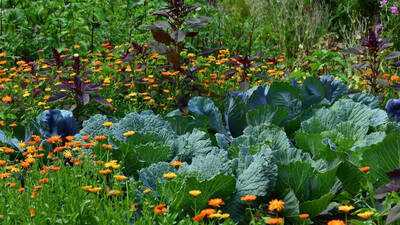Gardening during the monsoon can be a delightful revival for your plants but only if you manage excess moisture, pests, and fungal attacks wisely. Too much water without proper care can lead to root rot, disease, and weak foliage. These curated tips will help you protect your garden through heavy rains, prevent common monsoon problems, and maintain lush, thriving plants all season long.
Essential monsoon gardening tips for your garden
Ensure proper drainage
Waterlogging suffocates roots and invites fungal diseases. Use pots with drainage holes or raise garden beds slightly. Improve soil structure by adding gravel or broken terracotta at the base. Trenches can also channel excess water away. Good drainage helps air circulate, prevents compaction, and keeps roots healthy.
Mulch your beds before heavy rains

Apply a 2–3 inch layer of organic mulch like straw, coconut husk, or dry leaves around plants. Mulch absorbs excess rainwater, stops soil erosion, and retains nutrients. As it breaks down, it enriches the soil and suppresses weeds, creating a protective barrier for delicate monsoon-loving plants.
Prune and trim in anticipation
Trim overgrown branches and remove dead foliage before monsoon begins. This opens up the canopy, improves airflow, and reduces shaded damp areas where disease can thrive. It also stimulates new healthy growth, especially in flowering plants, making them more resilient to heavy rain.
Choose rain‑friendly plants

Opt for species that tolerate humidity well, like hibiscus, marigold, rain lilies, coleus, begonias, and ferns. These thrive despite damp soil and minimal sunlight. Indigenous or native plants often require less maintenance and naturally resist local pests and weather challenges.
Support tall or vining plants
Use bamboo stakes, garden twine, or trellises to support fragile stems like tomatoes, beans, or cucumbers. Secure plants gently to avoid damage, and position supports firmly in the soil. Proper support improves airflow around foliage and keeps fruit from rotting on wet ground.
Shift pots and avoid overwatering

If your plants sit outdoors, move pots under a canopy or indoors during heavy storms. Avoid adding water when it’s raining. Only water when the top inch of soil feels dry to limit root rot and fungal growth in already moist conditions.
Monitor pests and fungal diseases regularly
Inspect plants for slugs, snails, aphids, or mildew daily. Use neem oil or homemade organic solutions to control pests. Remove yellowing leaves and prune infected parts promptly. Early action keeps infestations from spreading during humid monsoon conditions.
Improve soil aeration and compost organically

Post-rain, loosen compacted soil gently using a trowel or fork to enhance root oxygen. Add organic compost or vermicompost before rains begin to boost nutrient levels and prevent nutrient leaching. Aerated, nutritious soil makes plants more resilient.
Use mulch and rainwater harvesting wisely
Cover vulnerable areas before heavy rainfall and use barrels or trays to harvest rainwater. This water is ideal for plants, free of chlorine and rich in minerals. Rainwater harvesting also reduces dependency on municipal water for sustained garden care.
Plant vegetables that thrive in the rain

Monsoon season is ideal for planting vegetables like spinach, okra , fenugreek, ginger, turmeric, and arbi (taro root). These crops flourish in damp conditions and yield well in nutrient-rich, moist garden soil, making the rainy season highly productive.
With simple yet smart gardening practices, from proper drainage and mulch to choosing monsoon-friendly plants, you can transform rainfall into a garden’s greatest asset. These tips ensure a pest-free, nutrient-rich, and thriving green space during India’s rainy season. Try different strategies and watch your garden flourish with seasonal resilience.
Also read| How to grow show-stopping dahlia blooms at home this season
Essential monsoon gardening tips for your garden
Ensure proper drainage
Waterlogging suffocates roots and invites fungal diseases. Use pots with drainage holes or raise garden beds slightly. Improve soil structure by adding gravel or broken terracotta at the base. Trenches can also channel excess water away. Good drainage helps air circulate, prevents compaction, and keeps roots healthy.
Mulch your beds before heavy rains

Apply a 2–3 inch layer of organic mulch like straw, coconut husk, or dry leaves around plants. Mulch absorbs excess rainwater, stops soil erosion, and retains nutrients. As it breaks down, it enriches the soil and suppresses weeds, creating a protective barrier for delicate monsoon-loving plants.
Prune and trim in anticipation
Trim overgrown branches and remove dead foliage before monsoon begins. This opens up the canopy, improves airflow, and reduces shaded damp areas where disease can thrive. It also stimulates new healthy growth, especially in flowering plants, making them more resilient to heavy rain.
Choose rain‑friendly plants
Opt for species that tolerate humidity well, like hibiscus, marigold, rain lilies, coleus, begonias, and ferns. These thrive despite damp soil and minimal sunlight. Indigenous or native plants often require less maintenance and naturally resist local pests and weather challenges.
Support tall or vining plants
Use bamboo stakes, garden twine, or trellises to support fragile stems like tomatoes, beans, or cucumbers. Secure plants gently to avoid damage, and position supports firmly in the soil. Proper support improves airflow around foliage and keeps fruit from rotting on wet ground.
Shift pots and avoid overwatering
If your plants sit outdoors, move pots under a canopy or indoors during heavy storms. Avoid adding water when it’s raining. Only water when the top inch of soil feels dry to limit root rot and fungal growth in already moist conditions.
Monitor pests and fungal diseases regularly
Inspect plants for slugs, snails, aphids, or mildew daily. Use neem oil or homemade organic solutions to control pests. Remove yellowing leaves and prune infected parts promptly. Early action keeps infestations from spreading during humid monsoon conditions.
Improve soil aeration and compost organically

Post-rain, loosen compacted soil gently using a trowel or fork to enhance root oxygen. Add organic compost or vermicompost before rains begin to boost nutrient levels and prevent nutrient leaching. Aerated, nutritious soil makes plants more resilient.
Use mulch and rainwater harvesting wisely
Cover vulnerable areas before heavy rainfall and use barrels or trays to harvest rainwater. This water is ideal for plants, free of chlorine and rich in minerals. Rainwater harvesting also reduces dependency on municipal water for sustained garden care.
Plant vegetables that thrive in the rain
Monsoon season is ideal for planting vegetables like spinach, okra , fenugreek, ginger, turmeric, and arbi (taro root). These crops flourish in damp conditions and yield well in nutrient-rich, moist garden soil, making the rainy season highly productive.
With simple yet smart gardening practices, from proper drainage and mulch to choosing monsoon-friendly plants, you can transform rainfall into a garden’s greatest asset. These tips ensure a pest-free, nutrient-rich, and thriving green space during India’s rainy season. Try different strategies and watch your garden flourish with seasonal resilience.
Also read| How to grow show-stopping dahlia blooms at home this season
You may also like

Hawaii on tsunami alert: Traffic gridlock as residents evacuate low-lying areas; flights diverted

Transfer news LIVE: Man Utd get £60m green light as Eberechi Eze to Arsenal takes twist

Diplomatic victory for India? TRF named in key UNSC report; published Pahalgam attack site photo, claimed responsibility twice

Japan nuclear panic after 8.8 magnitude Russian earthquake sparks Fukushima fears

BBC Great British Sewing Bee fans 'not happy' after 'boring' challenge





